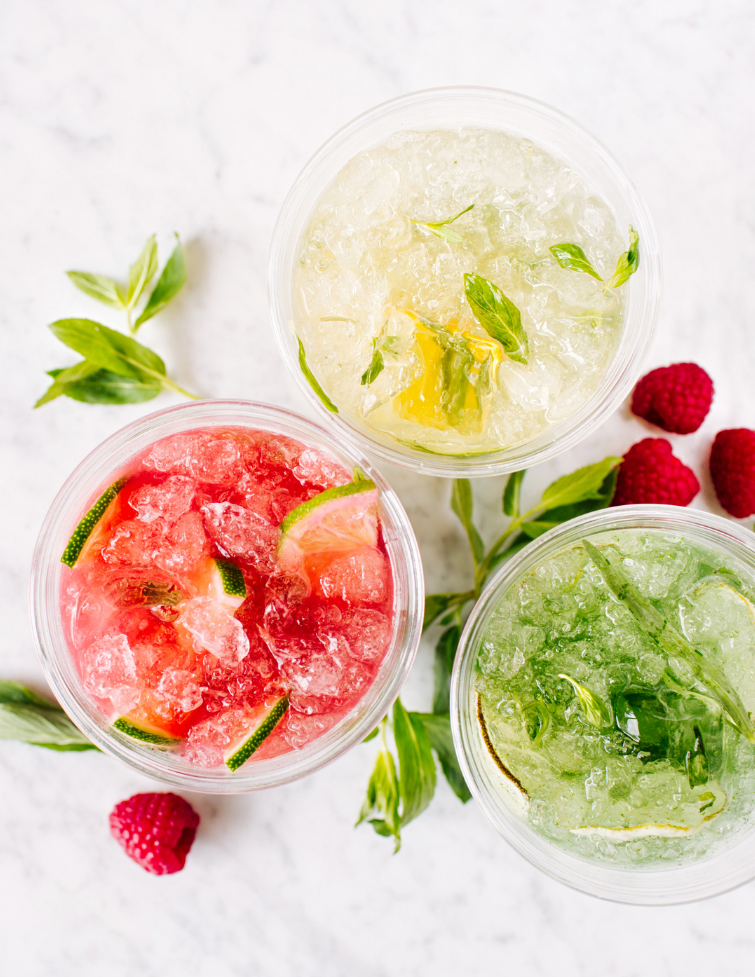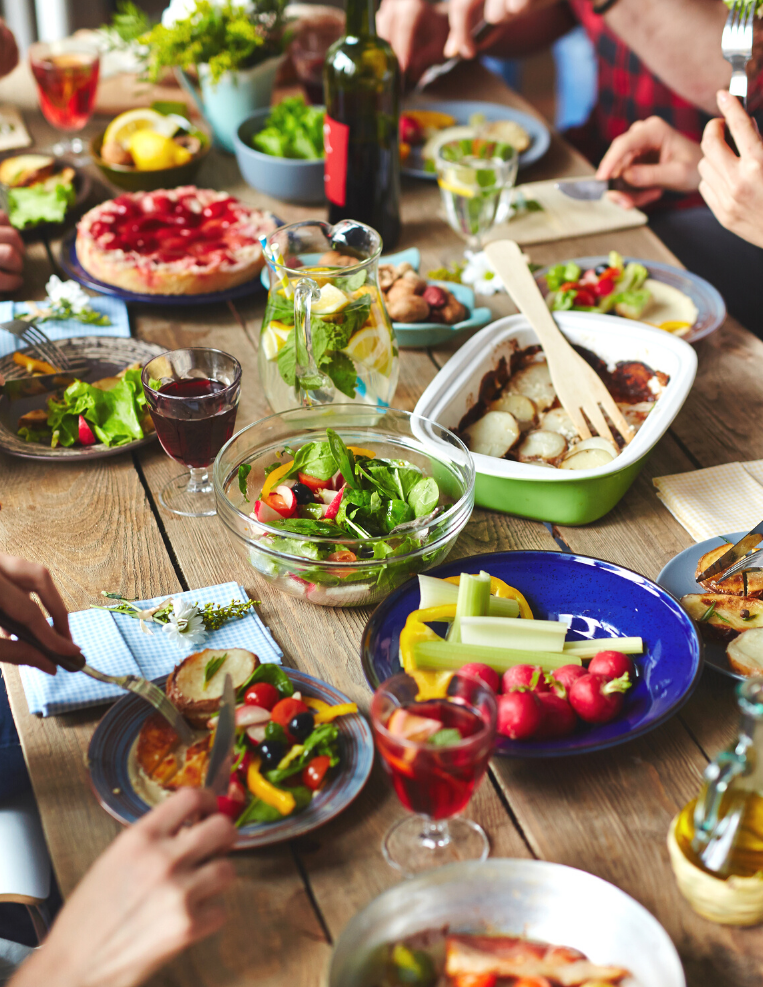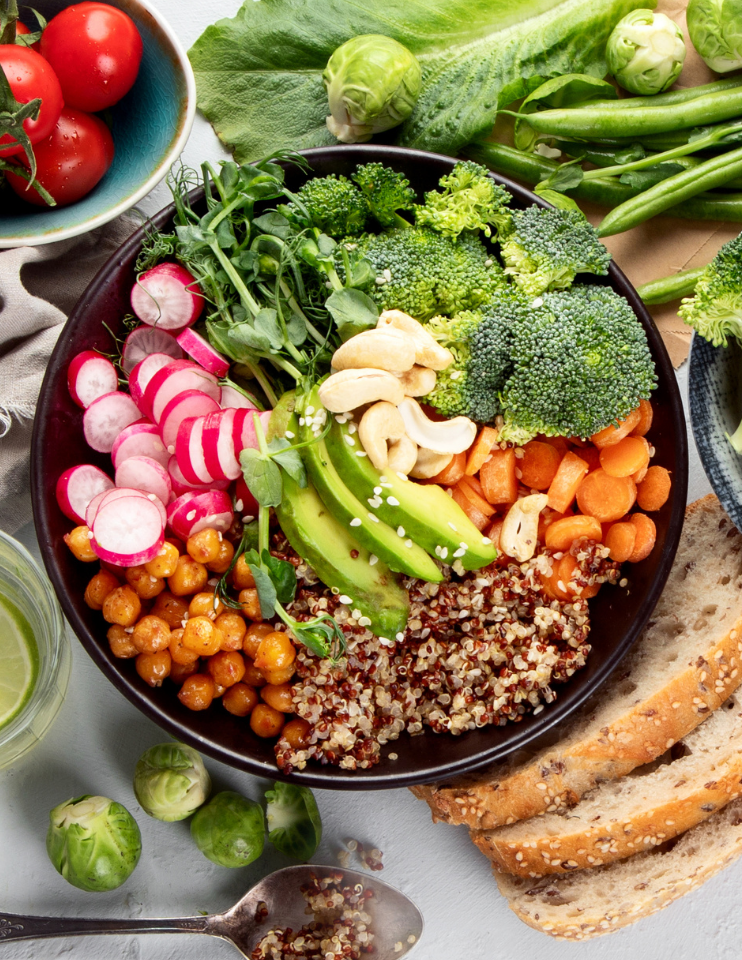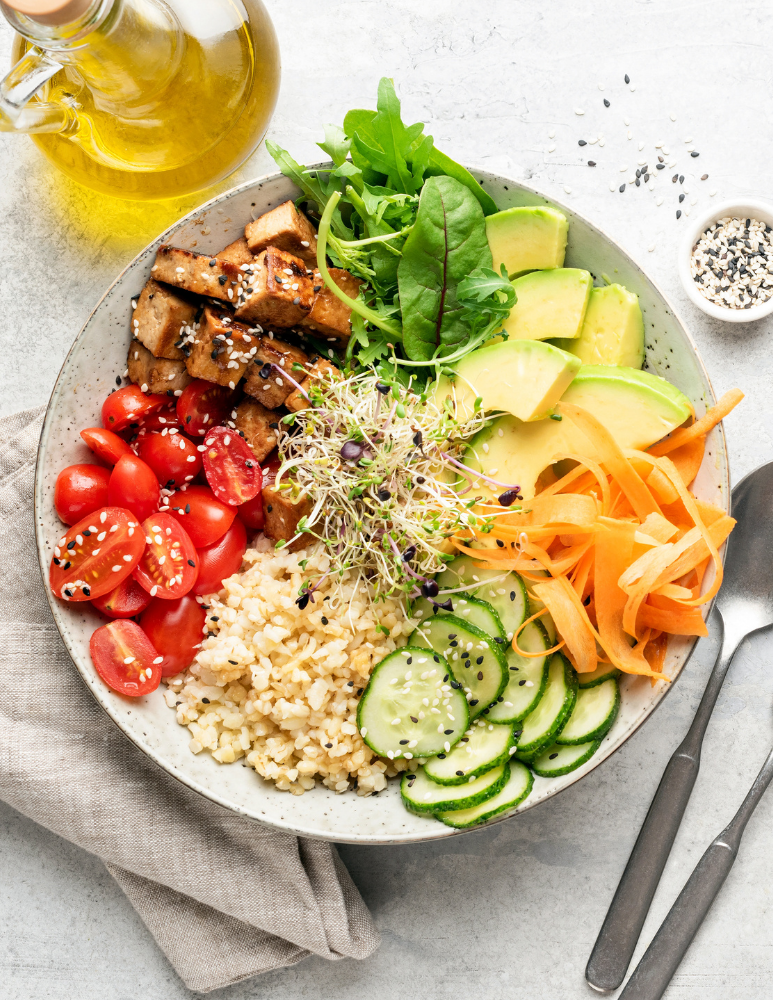If you are looking to lose some weight, the good news is that you don’t have to embark on crazy, restrictive, or depressing diets. The ultimate guide to vegan weight-loss is all you need to start working toward healthy, sustained weight-loss!
While going vegan can lead to naturally slimming down, it can equally lead to weight-gain – especially if you regularly pig out on all the incredible vegan treats available these days. (Yeah vegan ice cream, we’re looking at you…).
In this guide, we want to teach you how to use a vegan diet to lose weight. We also want to give you the knowledge and inspiration that will help you cultivate a healthier attitude toward eating. This will lead to a better relationship with food and more sustainable weight management overall.
Table of contents

Understand Calorie Density
Firstly, when it comes to losing weight, understanding calorie density should be step 1.
Simply put, the lower calorie dense a food is, the less calories there are per bite.
Now, this is different to counting calories. Calories do count, but we really don’t need to count them, and we really shouldn’t have to! Unless you’re a bikini competitor, body builder, or some kind of athlete where the numbers make a huge difference, there’s no need for weighing our food and counting every calorie.
For most of us, the answer actually lies in shifting our focus to eating whole, or minimally processed, fruits, vegetables, grains, legumes, nuts, and seeds, while keeping calorie density in mind.
Let me explain…
Your body requires a certain number of calories per day to maintain its current weight. To lose weight, you must give your body less calories than it needs, creating a calorie deficit.
The thing is, most of the time, we tend to believe we’re eating fewer calories than we really are, which can be super confusing when you don’t see the changes in your figure that you desire.
This is especially common when eating fiber-poor, ultra-processed foods, which make up 58% of our total calories in the US alone!
This warped perception of calorie-consumption is why most people find calorie-counting to be helpful, as it provides a clearer picture on exactly how much they’re eating. However, while it can be helpful, calorie-counting can affect mental health and lead to eating disorders.

So, rather than counting every calorie, try making shifts from higher-calorie-density foods to lower-calorie-density foods. This will allow you to eat the same volume of food while hopefully creating a calorie deficit… without counting calories on an app.
Keep in mind that we only need to create a deficit of 300-500 calories per day to achieve sustainable weight-loss. Slow and steady wins the race here!
Here are some examples of switching from higher-calorie-density foods to lower-calorie-density foods:
- Dried fruits ➡️ fresh berries
- Granola ➡️ rolled oats
- Chips ➡️ popcorn
- Spaghetti ➡️ spaghetti squash
- White rice ➡️ quinoa
By learning and understanding food calorie densities, the key to sustainable weight-loss is to then create a dietary pattern that is naturally full of these foods!
This is what will allow you to stop counting calories, stop depriving yourself, and stop uncontrollable cravings, and instead, allow you to learn how to eat intuitively.
The reason why vegan weight-loss can be so much simpler is because plant foods in their whole form are overall much less calorie-dense than animal foods and ultra-processed foods.
They also contain a lot of water and fiber, which fills our tummies and feeds our good gut bacteria. This results in the production of appetite-suppressing hormones, and the decreasing of our appetite-stimulating hormones.
The end result? Feeling full while consuming less.

Choose the Right Calories
“A calorie is a calorie” – there is some truth in that statement.
In theory, if you ate nothing but fries all day and still stuck to a calorie deficit, you would lose weight. But, no one is likely to sustain that long-term or feel good while doing it. (We don’t suggest trying this, as it’s not the healthiest strategy!).
While the number of calories is important, choosing the RIGHT calories can make your vegan weight-loss journey much healthier, not to mention easier.
For example, eating more whole foods – vegetables, fruits, grains, legumes, nuts and seeds – is a better way to enjoy your calories while boosting your health compared to eating, say, potato chips and donuts.
Whole foods are generally lower in calories as mentioned above (they have lower calorie densities) while being higher in fiber, so you will feel more satisfied with less food.
On a similar note, while we don’t advocate avoiding specific macronutrients, do be conscious of your fat intake, as foods in this category tend to be higher in calories.
Fat contains 9 calories per gram, while carbohydrates and protein only contain 4 calories per gram. Eat healthy fats like avocado, nuts, seeds, and olive oil – because your body needs them – but be aware of how much of those foods you’re eating.
Here’s an example just to put things into perspective:
- 1 tablespoon of almond butter (a fat) has almost 100 calories
- 1 tablespoon of quinoa (a starchy carb) has almost 40 calories
- 1 tablespoon of asparagus (a non-starchy carb) has 2 calories
- 1 tablespoon of tofu (a protein) has about 12 calories
Can you see how this can affect your weight-loss?

Eat Your Protein
Of the three macronutrients (protein, fat, and carbs), protein is perhaps the most important, for a few reasons.
Firstly, protein digests the slowest, which means you feel fuller for longer. This is important when you are limiting your calories and battling hunger.
Protein also takes more calories to digest. In fact, you burn around 30% of the calories in the protein you eat simply by digesting it!
Finally, protein helps your body retain lean muscle mass, and muscle is something you want to hold onto while you lose fat since it helps to maintain vegan weight-loss, or any kind of weight-loss!
So, aim to include protein-rich, whole plant foods such as tofu or lentils at every main meal. Our guide to the best vegan protein sources will help you!
We have also prepared a list of the best vegan protein powders in our eyes, which may give you some inspiration for post-workout smoothies if you’re a fan of those.

Consider Your Environment
It’s easy to say ‘eat more vegetables and less cookies’, but if your kitchen is full of vegan cookies with no vegetables in sight, it’s not as easy.
Try paying attention to your environment and make it more conducive to losing weight.
This means having a bit of a clear out and doing some shopping.
Go through your cupboards and remove any of the high-calorie, low-nutrient foods and give them away.
If any of them are your favorite treats and you want to include them in your diet/eat them in moderation, move them somewhere out of easy access, like the garage or basement, perhaps!
Next, you can fill all of that empty shelf-space with those supportive foods we have already mentioned – things like vegetables, fruits, grains, legumes, nuts and seeds.

Be Careful of Liquid Calories
Most people don’t consider juices, cocktails, or other beverages when being conscious of their calorie-consumption. The problem with this is that it’s too easy to consume a lot of calories from these!
The most common beverages high in calories are:
- Fruit juices
- Soft drinks, like sodas
- Energy drinks
- Shakes/Smoothies (not always, but usually are when they aren’t homemade)
- Your favorite Frappuccino, and other extravagant coffee beverages
- Alcoholic drinks (cocktails, wine, beer)
While many of those are self-explanatory, two that aren’t are smoothies and alcohol.
Store-bought smoothies can be incredibly deceptive when it comes to the total sugar and calorie content. Most of the time, smoothie shops mention the ingredient list, but even if the ingredients are all technically healthy, it doesn’t mean they have low calorie densities.
And, as we learned above, understanding calorie density is key to vegan weight-loss!
They might include sweetened fruit juices, sweetened açaí, calorie-dense protein powders, sweetened milk, sweetened yogurt, coconut cream, nut butters, and calorie-dense fruit (like dates).
While some of these ingredients are healthy, the calorie density of a store-bought smoothie can easily increase by using a combination of these ingredients to sweeten or thicken a smoothie.
Therefore, it’s much better to make smoothies at home! You can be in full control of what goes inside.

Alcohol is the second one on this list that needs a little more explanation.
Alcohol intake is one of the biggest factors to be mindful of when focusing on weight-loss, and an important note is that the calories in alcoholic drinks don’t just come from the sugar in them, as most of us are led to believe.
The compound ethyl alcohol, or ethanol, contains seven calories per gram, meaning that even 1 shot of pure vodka (or 1 shot of pure tequila, or 1 shot of pure rum) contains about 97 calories (almost 100 calories in 1 shot!), while 1 shot of pure whiskey contains about 105 calories.
This means that the higher the alcohol percentage, the more calories that alcohol contains from this compound. Crazy, right?!
Other than the actual alcohol calorie amount, research shows that when people drink, they usually also eat more calories and move less, making it more likely for you to fall into a calorie surplus.
If you’re looking for low-calorie, healthy beverages, here are our faves:
- Naturally infused water
- Homemade iced tea
- Coconut water
- Homemade veggie and fruit smoothies
- Coffee (just be mindful of what you add to it!)
- Tea (also be mindful of what you add to it!)

Master Your Eating Habits
We’ve discussed what to eat to achieve vegan weight-loss, but now let’s look at how to eat.
One of the most powerful things you can do to lose weight is SLOW DOWN. How often do you gobble your food down quickly, whether at home or at work (or even while driving!)?
Eating slowly gives you a better chance of noticing fullness cues, before you overeat and get too full. It can also improve your digestion, which is always a benefit.
Importantly, studies have found that eating slowly can result in naturally taking in fewer calories per meal. Over time, this adds up!
So commit to some actions that will help you eat slower at mealtimes. This may be putting the fork down in between bites, taking a sip of water in between bites, timing your meals so that they are a little longer each time, etc.
Simply put: the slower you eat, the better.
Here are some other strategies you can use around how to eat:
- Eat as many home-cooked meals as possible. People who cook dinner 6-7 times per week consume around 1000 fewer calories over a week, according to a study that looked at over 9,000 adults.
- Aim to stop eating when you’re 80% full to allow your body time to process the food and signal that it is full.
- Drink water 30-60 minutes before your main meals to increase feelings of fullness.
- If you’re feeling stressed or emotional, try taking a break or taking some deep breaths to relax before eating. When you stress-eat, you’re more likely to over-consume.

Lift Weights
When trying to lose weight, people often head straight for the treadmill to run away the calories. But in terms of losing weight, it is more important to create your calorie deficit through your diet than by heading to the gym.
No amount of exercise can counteract an unhealthy diet, and thinking of exercise as the key to a healthy bodyweight is misguided. You can’t outrun a bad diet!
While physical activity is a much smaller contributor to bodyweight than the food you consume several times a day, there are big benefits to exercise, and you should definitely incorporate it in your weight-loss journey.
In terms of what kind of exercise, most people see cardio, like running, cycling, and swimming as the most effective route to burning calories. While it is effective, don’t underestimate the power of resistance training for weight-loss!
By working out with weights – from barbells to bodyweight – you will be able to maintain your muscle mass while you lose fat.
Muscle is a metabolically active tissue, meaning it burns calories just by being there. Fat, on the other hand, does not. So it is beneficial to have muscle mass while you are trying to lose weight.
Our guide to vegan muscle building should give you a good idea of what to do, although it’s best to consult a personal trainer if you have any doubts.
You can certainly add in some cardio if you enjoy it, as cardio comes with more benefits for your body than simply burning calories!
Walking and general daily activities are also an excellent way to burn calories, so try to include as much activity in your day as possible.

Putting it All Together
Follow the advice above and you will have a clearer path to achieving vegan weight-loss in a healthy and sustainable way.
Remember to be kind to yourself – weight-loss is a tough process and is far from instant. Don’t forget to treat yourself each time you hit a new goal!
Be persistent, be consistent, and you will see results. Good luck!

